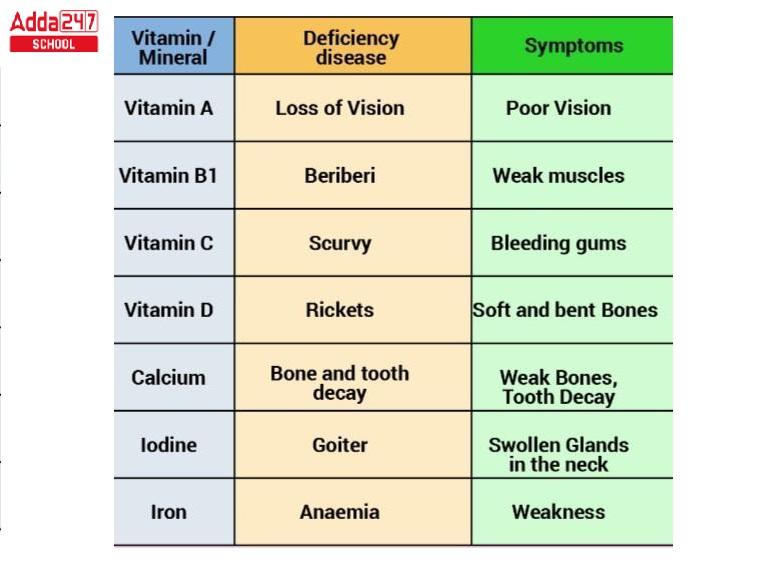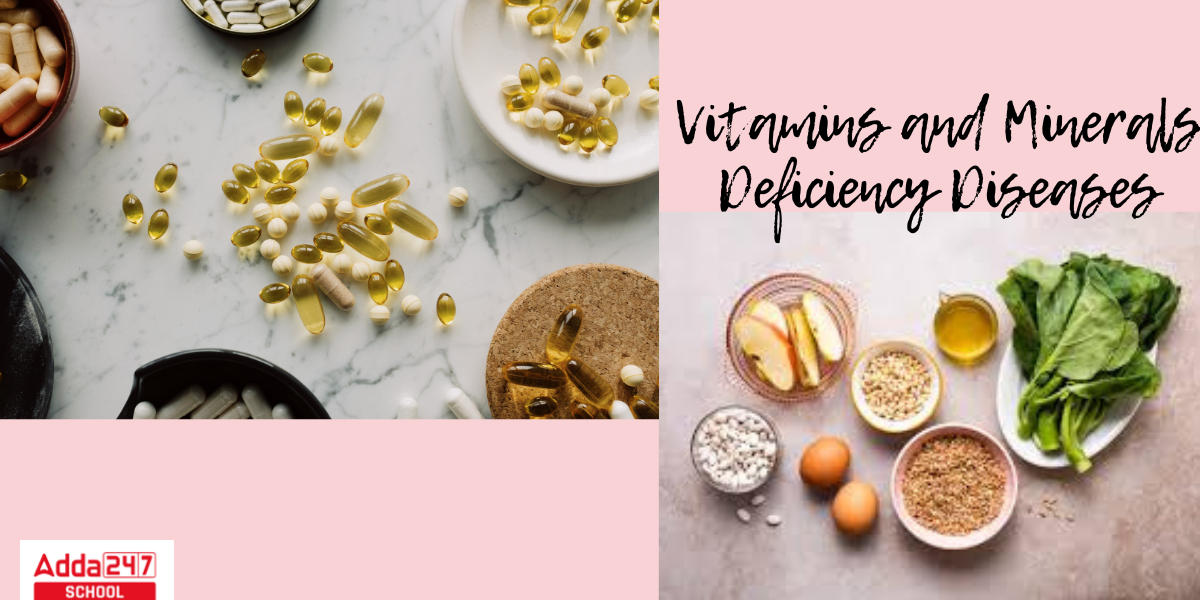Table of Contents
Vitamins and Minerals deficiency Diseases are a long-term shortage of essential amines in human bodies. In comparison to carbohydrates, proteins, and fats, the body requires extremely little amounts of these nutrients to function properly. Yet ingesting too little or excessive amounts of vitamins and Minerals can be physiologically damaging. Vitamin and Minerals deficiencies can lead to disorders like beriberi, Goiter, Beri-Beri, pellagra, and more. People of all ages are affected by vitamin deficiencies, which frequently occur with mineral deficiencies like zinc, iron, and iodine. It is important to know all the Vitamins and Minerals Deficiency Diseases and how to cure them.
Vitamins Deficiency Diseases
Vitamin insufficiency is still a worldwide issue specially in underdeveloped countries. Vitamins and Minerals Deficiency Diseases are usually clinically unnoticed unless severe, but even a little deficit might have devastating consequences.
Vitamins are denoted by the letters A, B, C, D, and so on. Some of them are further classified as sub-groups, such as B1, B2, B6, B12, and so on. A primary deficiency occurs when there is a lack of vitamin intake, but a secondary deficiency occurs when there is a lack of vitamin absorption owing to a problem. A person may be getting enough food to consume, but the diet may lack a specific nutrient. If this occurs for an extended length of time, the person may develop a deficit.
Vitamins Chart
chart outlining the main vitamins, their functions, food sources, and potential deficiency symptoms:
| Vitamin | Function | Food Sources | Deficiency Symptoms |
|---|---|---|---|
| Vitamin A | Supports vision, immune system, and skin | Carrots, sweet potatoes, spinach, liver, eggs | Night blindness, dry skin, increased susceptibility to infections |
| Vitamin B1 | Helps convert food into energy | Whole grains, pork, nuts, seeds, legumes | Beriberi (nerve damage, heart problems) |
| Vitamin B2 | Supports energy production, skin health | Dairy products, eggs, lean meats, green leafy veggies | Cracks at corners of mouth, skin inflammation |
| Vitamin B3 | Supports metabolism, nervous system | Meat, poultry, fish, whole grains, nuts, mushrooms | Pellagra (skin rash, diarrhea, dementia) |
| Vitamin B5 | Supports energy metabolism, hormone synthesis | Avocado, meat, poultry, whole grains, legumes | Fatigue, weakness, digestive problems |
| Vitamin B6 | Supports brain function, metabolism | Meat, fish, poultry, bananas, potatoes, nuts | Anemia, depression, confusion |
| Vitamin B7 | Supports metabolism, skin health | Eggs, nuts, seeds, sweet potatoes, avocados | Hair loss, skin rashes, neurological symptoms |
| Vitamin B9 | Essential for DNA synthesis, cell growth | Leafy greens, legumes, citrus fruits, liver | Neural tube defects in newborns, anemia |
| Vitamin B12 | Supports nerve function, DNA synthesis | Meat, fish, poultry, dairy products, fortified foods | Anemia, neurological symptoms, fatigue |
| Vitamin C | Antioxidant, supports immune system | Citrus fruits, strawberries, bell peppers, broccoli | Scurvy (fatigue, bleeding gums, weak immune system) |
| Vitamin D | Supports bone health, immune function | Sunlight, fatty fish, fortified dairy products | Rickets (weak bones), weakened immune system |
| Vitamin E | Antioxidant, supports immune system | Nuts, seeds, vegetable oils, leafy greens | Nerve damage, muscle weakness, vision problems |
| Vitamin K | Supports blood clotting, bone health | Leafy greens, cruciferous vegetables, dairy products | Excessive bleeding, weakened bones |
This chart provides a basic overview, but it’s important to remember that individual nutritional needs can vary based on factors such as age, sex, health status, and lifestyle. Consulting with a healthcare professional or registered dietitian can provide personalized recommendations.
What are Vitamins and Their Deficiency?
Vitamins and minerals are a broad set of chemicals that play a wide range of functions in the body. Vitamins are chemical compounds that are required in tiny quantities in our diet but induce certain ailments when deficient. Most vitamins cannot be synthesized in our bodies, but plants can synthesize almost all of them, making them vital food elements.
Fat soluble vitamins
Vitamins A, D, E, and K are examples Fat soluble vitamins. This category contains vitamins that are soluble in fat and oils but insoluble in water. They are kept in the liver and the adipose tissues.
Water soluble vitamins
B group vitamins and vitamin C are water-soluble, they are classified together. Water-soluble vitamins must be consumed on a regular basis because they are eliminated in urine and cannot be stored in our bodies (save for vitamin B12).

Vitamin Deficiency Symptoms Chart
Vitamin deficits are particularly common in infants and young children. Pregnant and breastfeeding women, in particular, have relatively high demands for these chemicals and are vulnerable to their absence. Among them are infectious disease, mortality, anaemia, death during pregnancy or childbirth, and impaired mental and physical development. Vitamin insufficiency has ramifications due to the metabolic roles they play. All Fat soluble vitamins and water soluble vitamins deficiency related Disease are discused below in vitamin deficiency diseases chart.
| Water-soluble Vitamins Deficiency Disease | |
| Name of Vitamin |
Deficiency Diseases
|
| Vitamin B1 (Thiamine) |
Weak muscles and severe weight loss (Beriberi)
|
| Vitamin B2 (Riboflavin) |
Poor diet and mouth sores (Ariboflavinosis)
|
| Vitamin B3 (Niacin) |
Diarrhea and Dermatitis (Pellagra)
|
| Vitamin B5 (Pantothenic acid) |
Ischemic attacks and multiple sclerosis that affect the brain (Paresthesia)
|
| Vitamin B6 (Pyridoxine) |
Low number or lack of Red Blood Cells (Anemia)
|
| Vitamin B7 (Biotin) |
Red and Itchy skin (Dermatitis)
|
| Vitamin B9 (Folic Acid/Folate) |
Immature RBCs (Megaloblastic Anemia)
|
| Vitamin B12 (Cyanocobalamin) |
Abnormal absorption in the small intestine (Pernicious Anemia)
|
| Vitamin C (Ascorbic Acid) |
Bleeding gums and swollen joints (Scurvy)
|
| Fat Soluble Vitamins Deficiency Disease | |
| Name of Vitamin |
Deficiency Diseases
|
| Vitamin A (Retinol) |
Loss of Vision (Blindness)
|
| Vitamin D (Calciferol) |
Weakening of bone near joints (Rickits)
|
| Vitamin K (Phylloquinone) |
Excessive Bleeding.
|
| Vitamin E (Tocopherols) |
Faster depletion of RBCs from the body (Hemolytic Anemia)
|
Vitamin A Deficiency Diseases List
Vitamin A deficiency can lead to various health issues, and here are some common diseases and conditions associated with it:
- Night Blindness: This is one of the earliest signs of vitamin A deficiency. It impairs the ability to see in low light conditions or at night.
- Xerophthalmia: A more severe form of eye condition caused by vitamin A deficiency, which can lead to dryness of the eyes, corneal ulcers, and eventually blindness if left untreated.
- Keratomalacia: This is a condition where the cornea becomes soft and can lead to irreversible blindness.
- Impaired Immunity: Vitamin A deficiency weakens the immune system, making individuals more susceptible to infections, especially respiratory infections and diarrheal diseases.
- Impaired Growth and Development: In children, vitamin A deficiency can lead to stunted growth and development, as well as increased susceptibility to infections.
- Skin Disorders: Vitamin A deficiency can result in dry, rough, and scaly skin.
- Increased Mortality in Pregnant Women and Children: Vitamin A deficiency during pregnancy can increase the risk of maternal mortality, and in children, it can increase the risk of mortality from infectious diseases.
List 10 Nutritional Deficiency Diseases
10 common nutritional deficiency diseases:
- Iron Deficiency Anemia: Caused by inadequate intake or absorption of iron, leading to reduced red blood cell production and resulting in fatigue, weakness, and pale skin.
- Vitamin D Deficiency: Insufficient intake of vitamin D or lack of exposure to sunlight can lead to weakened bones (osteomalacia in adults, rickets in children), muscle weakness, and increased risk of fractures.
- Calcium Deficiency: Inadequate calcium intake can result in weakened bones (osteoporosis) and teeth, muscle cramps, and spasms.
- Vitamin B12 Deficiency: Lack of vitamin B12, often due to poor dietary intake or absorption issues, can lead to anemia, fatigue, weakness, neurological problems, and tingling or numbness in the hands and feet.
- Iodine Deficiency Disorders: Inadequate iodine intake can lead to iodine deficiency disorders such as goiter (enlarged thyroid gland), hypothyroidism, and cretinism (a condition characterized by mental and physical retardation).
- Vitamin A Deficiency: As mentioned earlier, vitamin A deficiency can cause night blindness, xerophthalmia, impaired immunity, and skin disorders.
- Folate (Vitamin B9) Deficiency: Insufficient folate intake can result in megaloblastic anemia, neural tube defects in newborns, and increased risk of cardiovascular diseases.
- Vitamin C Deficiency (Scurvy): Inadequate intake of vitamin C can lead to scurvy, characterized by fatigue, weakness, swollen and bleeding gums, joint pain, and poor wound healing.
- Zinc Deficiency: Lack of zinc can result in impaired immune function, growth retardation, delayed sexual maturation, hair loss, and skin lesions.
- Protein-Energy Malnutrition: Inadequate intake of protein and/or calories can lead to protein-energy malnutrition, including conditions such as kwashiorkor and marasmus, characterized by muscle wasting, stunted growth, weakened immunity, and edema.
What are Minerals?
Minerlas are inorganic nutrients that serve an important part in maintaining health and well-being. Copper, iodine, iron, manganese, selenium, and zinc are among the trace elements, as are the macro elements calcium, magnesium, potassium, and sodium. Other minerals, such as selenium, cobalt, and molybdenum, are also required in trace amounts by the body. These elements are recognized to serve a purpose in the human body.
Macrominerals
Macrominerals are minerals that must be consumed in relatively large quantities. As a result, they are also known as significant minerals.
Sodium, calcium, chloride, magnesium, potassium, phosphorus, and sulphur are examples of macrominerals.
Microminerals
These minerals, often known as trace minerals, are required in trace amounts. As a result, they are sometimes known as minor minerals. Iron, copper, iodine, zinc, manganese, fluoride, and cobalt are examples of trace minerals.
Minerals Deficiency Diseases Name
It is critical to have a well-balanced and diverse diet to ensure you acquire enough minerals to avoid these deficiency-related diseases. The following is a list of important mineral deficiency disorders caused by a lack of vital minerals.
| Minerals Deficiency Diseases | |
|
Name of Minerals
|
Deficiency Diseases
|
| Calcium |
Brittle bones, excessive bleeding
|
| Phosphorus |
Bad teeth and bones
|
| Fluorine | Dental Cavities |
| Iron | Anaemia |
| Sodium |
Nervous depression, improper muscle contraction, loss of Na+ in urine, dehydration.
|
| Chlorine |
Vomiting and hypochloremic alkalosis
|
| Iodine |
Goitre, enlarged thyroid gland
|
| Copper |
Low appetite, retarded growth
|
| Magnesium |
Heart and Vascular irregularities, dilated blood vessels, and loss of coordination
|
Vitamins and Minerals Deficiency Diseases Chart
Vitamins and Minerals Deficiency Diseases Chart is given below here in this article.

Vitamins and Minerals Deficiency Diseases Prevention
Most people obtain adequate vitamins from their diet.Some types of vitamin deficiency anaemia can be avoided by eating a well-balanced diet that includes a range of foods.
- If you are deficient in Vitamin B12, you can prevent diseases by include B12-rich foods in your diet. Vitamin B-12-rich foods include- Beef, liver, chicken, fish, Eggs, Breakfast cereals and other fortified meals, Yoghurt, milk, and cheese.
- Broccoli, spinach, asparagus, and lima beans are all high in folate. Melons, oranges, lemons, bananas, strawberries, and bananas are the options.
- Bread, cereal, pasta, and rice are examples of enriched grain products.
- Peanuts, liver, kidneys, yeast, and mushrooms are enriched with nutritional values.
- Fermentation and sprouting both preserve and enhance the nutritional content of food.
- Most adults require the following daily dietary quantities of vitamins – 2.4 micrograms (mcg) vitamin B-12 and 400 micrograms (mcg) of folic acid or foliate. But Women who are pregnant or breastfeeding may require more of each vitamin.
- Long cooking times and undercooked food lose nutritional value. Keeping sliced vegetables and fruits for an extended period of time reduces their nutritional value. By avoiding this, you can avoid deficient disorders.



 NEET UG 2025: Is NEET Previous years Que...
NEET UG 2025: Is NEET Previous years Que...
 JEE Mains Session 2 Result 2025 OUT, Sco...
JEE Mains Session 2 Result 2025 OUT, Sco...
 TS Inter Results 2025 Date for TSBIE 1st...
TS Inter Results 2025 Date for TSBIE 1st...










